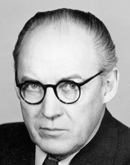

Sigurd Lewerentz
Biography
Sigurd Lewerentz was a Swedish architect. He originally trained as a mechanical engineer at the Technical University of Gothenburg (1905-08). Later, he trained as an architect in Germany. In 1911, he opened his own office in Stockholm and collaborated with architect Gunnar Asplund. Together, they created the winning design for the Forest Cemetery in Stockholm in 1914-15. Along with Asplund, they were appointed as the chief architects for the International Exhibition in Stockholm (1930). Subsequently, he left the field of architecture for many years, and from 1940, he operated a factory for window and hardware production based on his own designs. From 1933 to 1944, he and his colleagues Erik Lallerstedt and David Helldén created a gem of Swedish functionalist architecture, the opera house in Malmö. In 1950, he was awarded the Prince Eugen Medal for architecture. In the last decade of his life, he designed a pair of sacred buildings: St. Mark's Church in Björkhagen, Stockholm (1955-63) and St. Peter's Church in Klippan, Scania (1963-66), which revived his architectural career.
Sigurd Lewerentz was a Swedish architect. He originally trained as a mechanical engineer at the Technical University of Gothenburg (1905-08). Later, he trained as an architect in Germany. In 1911, he opened his own office in Stockholm and collaborated with architect Gunnar Asplund. Together, they created the winning design for the Forest Cemetery in Stockholm in 1914-15. Along with Asplund, they were appointed as the chief architects for the International Exhibition in Stockholm (1930). Subsequently, he left the field of architecture for many years, and from 1940, he operated a factory for window and hardware production based on his own designs. From 1933 to 1944, he and his colleagues Erik Lallerstedt and David Helldén created a gem of Swedish functionalist architecture, the opera house in Malmö. In 1950, he was awarded the Prince Eugen Medal for architecture. In the last decade of his life, he designed a pair of sacred buildings: St. Mark's Church in Björkhagen, Stockholm (1955-63) and St. Peter's Church in Klippan, Scania (1963-66), which revived his architectural career.
The English translation is powered by AI tool. Switch to Czech to view the original text source.











